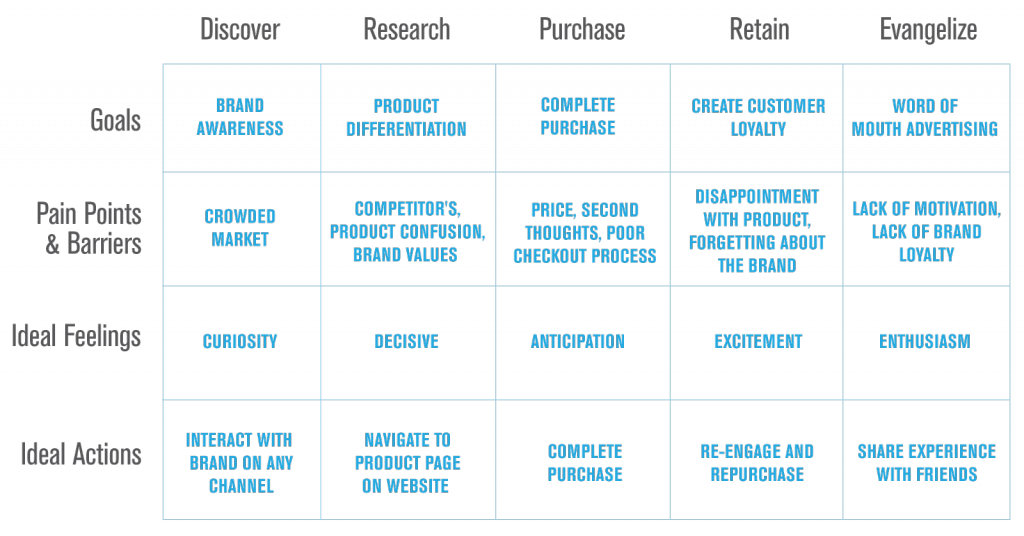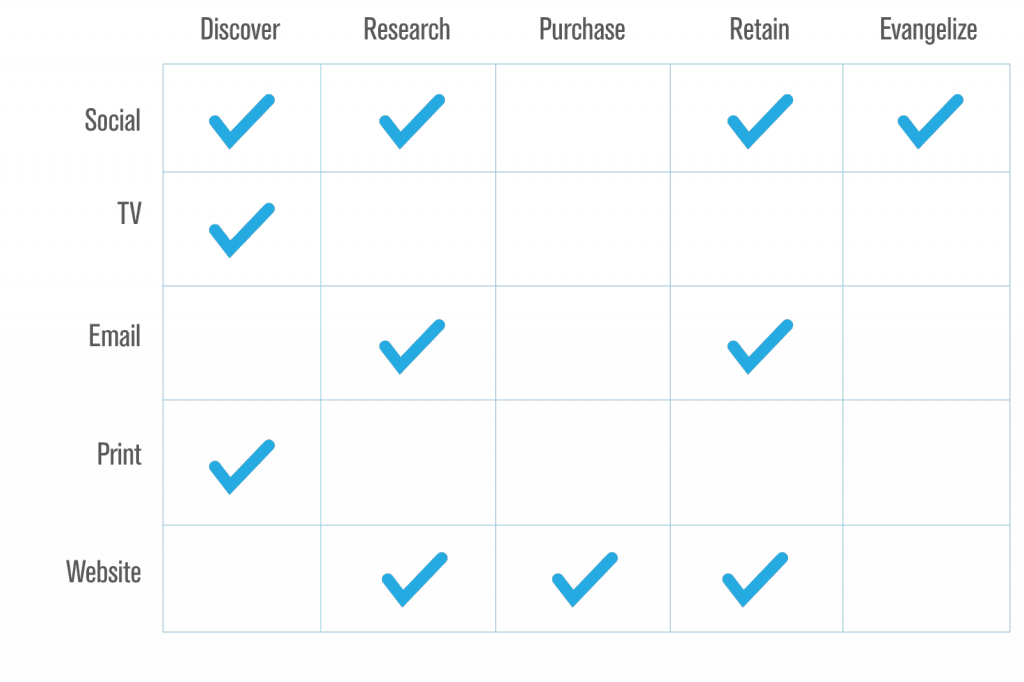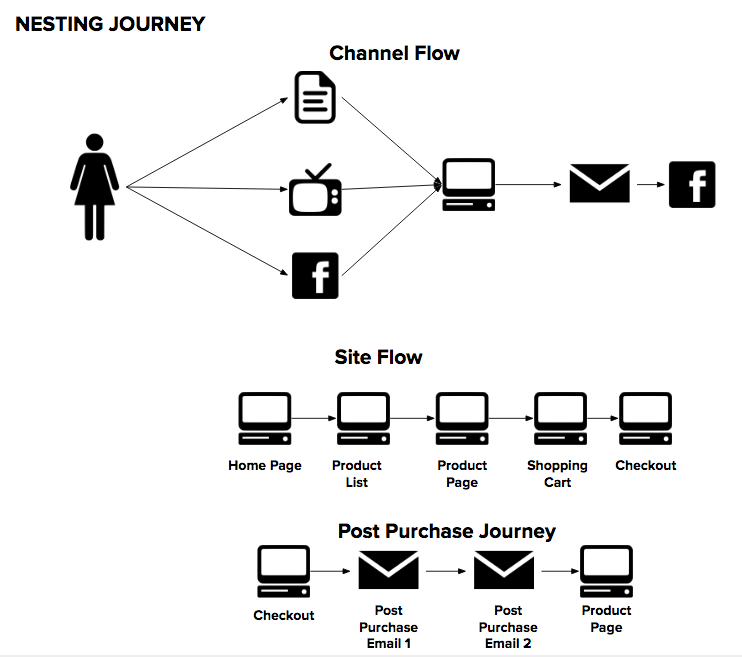
In the current world of marketing, everything is about your audience. We see it in brands’ and advertisers’ focus on personalization and targeting, including hypertargeting. One element all of these things have in common is that they identify who your audience is, but what does your audience do?
To answer that question, you need to develop a customer journey. Every single interaction your audience has with marketing, sales and customer service affects how consumers feel about you. A customer journey looks at these interactions and sentiments, mapping out customers’ behaviors when interacting with your brand.
That may sound overwhelming. For many brands of various sizes, it can be hard to keep everything top of mind. It may also be difficult to keep them in perspective when you have a big, modern marketing machine running 24/7 on numerous channels, each with its own metrics and optimizations.
When a brand spends too much time and effort in the tactical execution on a channel level, the company runs a real risk of optimizing itself out of its audience. This is especially true if you measure each channel only by conversion or revenue. A direct mail piece giving a customer 30% off their purchase might be the best-converting and most revenue-generating ad. But, it may also bring in customers who are only shopping based on price, and will move on if a competitor gives them a better deal.
That’s why we need customer journeys: to understand how customers move through their decision-making processes, and to define how each marketing channel fits into that lifecycle. If you can map out a customer’s journey, you’ll have a better understanding of your customers’ mindsets and needs, and how your marketing efforts can better serve those needs.
Getting Started
Customer journeys may involve as much art as science, but they do require some data collection upfront. To get started, dive into your analytics accounts, social media data, email metrics, SEM programs—anything that can help you see the big picture. Where do you notice people converting at the highest frequency? Which channels drive lots of clicks, but little revenue? Look for any unusual or unexpected information.
The second step is talking with your customers. Find out what they were thinking and feeling when they made their decisions to buy from you. What challenges did they face? What did they feel like immediately after the purchase? What did they feel three months later? Once again, keep an open mind and you may encounter some surprises.
Constructing Your Customer Journey
Armed with data, you’re ready to build your journey. There are as many ways to construct customer journeys as there are people making them, so your unique methodology may differ from what you read below. Use this as a guide and adapt it to your own particular business:
Step 1: Identify Your Customers
Unless you’re selling a single product to a very niche market, you probably have at least two or three distinct types of customers. Use the data and interviews you’ve gathered and divide your audience into groups. Be specific but not too granular. The smaller the distinctions between groups, the less their journeys will deviate from each other. That means more work with less payoff. For instance, “Weekly Purchaser” and “Yearly Purchaser” are likely better categories than “Women 20-22 years old” and “Women 23-24 years old.” If you have a customer group that you’d like to cater to, but don’t currently, add them to this list as well.
Step 2: Map Out Their Buying Phases
Map out the phases in each customer group’s life cycle. A phase should be distinct from the others and include specific actions that separate it from the phases before and after. A generic lifecycle might look like: Discover, Research, Purchase, Retain, Evangelize.
Step 3: Find the “Shifts”
This is the hardest step by far. It’s also the step in which your interviews and data are going to help the most. For every phase, ask yourself: What will move a customer along to the next one? Where are the barriers? What pain points exist in your own process? What actions signal movement from one phase to the next? Keep in mind that customers will often move backwards in the process.
I like to chart it all in a table to keep it organized. Here’s an example of what this might look like:

Step 4: Match Each Phase to a Channel
This step defines which channels best align with each phase of the customer lifecycle. Here’s another table that might help you visualize the relationships:

By defining each channel’s role in the process, you’re also identifying what metrics make sense for each. For example, you might want to measure conversion for any content used in the Research and Retain phases, but not necessarily for Discover and Evangelize. As a result, you could decide to run multiple campaigns on every channel—each campaign with specific targeting and goals.
Step 5: Drill Down
Once you’ve wrapped up the necessary high-level thinking, your final step is to tweak and refine the details. All phases and channels may have their own individual journeys, which you can map out, using the overall journey as a guide. For example, if you’re mapping the journey for a website, you could create a journey for each page if necessary.
Visualize and Win
The output of this work should be something visual that can be shared around your organization. It’s important to make your visual clear and easy to understand. Leave out any data that isn’t absolutely critical. Most likely, not all of the information you’ve mapped will make it into the final product you present to your organization.
Designers and agencies can help put all of this into context, if you have the resources to enlist their services. Since that’s not always an option, here are a few simple templates.
1. The Sample Journey
If a certain group of people (like a board of directors) needs to see the customer journey but won’t be referring to it on a daily basis, this is a great method for illustrating the output of the work. This is a specific journey that includes every phase and touch points—think of it as a map of your ideal customer:

2. Nesting Dolls
This visual maps out multiple journeys mapped based their granularity. Each journey gets more specific than the one previous. You may find this visual helpful for defining channel flows, movement through a website, or whenever you have too much information to fit into one visual.

3. The Fire Hose
This is the one visual to rule them all. It’s everything all in one place—who cares if it’s the size of a whiteboard? Seriously. Remember how I just said to make it simple? Well, if you’re really enterprising and need to communicate every last detail, ignore my advice and get to work. This is a great visual to print out in massive dimensions and hang in the meeting room in which you do your planning.
Looking for Fire Hose samples? This visual is too big to include here. Instead, I recommend doing a Google image search—you’ll find plenty of inspiration.
There it is,your customer journey: a living, breathing representation of your customers that goes way beyond personas or segments. Use it when you make marketing decisions, or when launching new products and revisit it from time to time to make sure it still aligns with your strategic goals.
